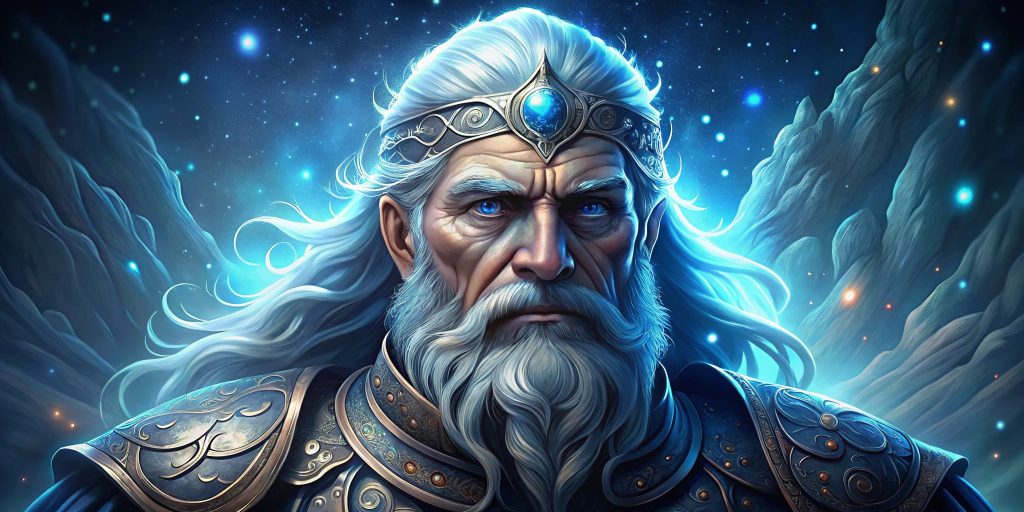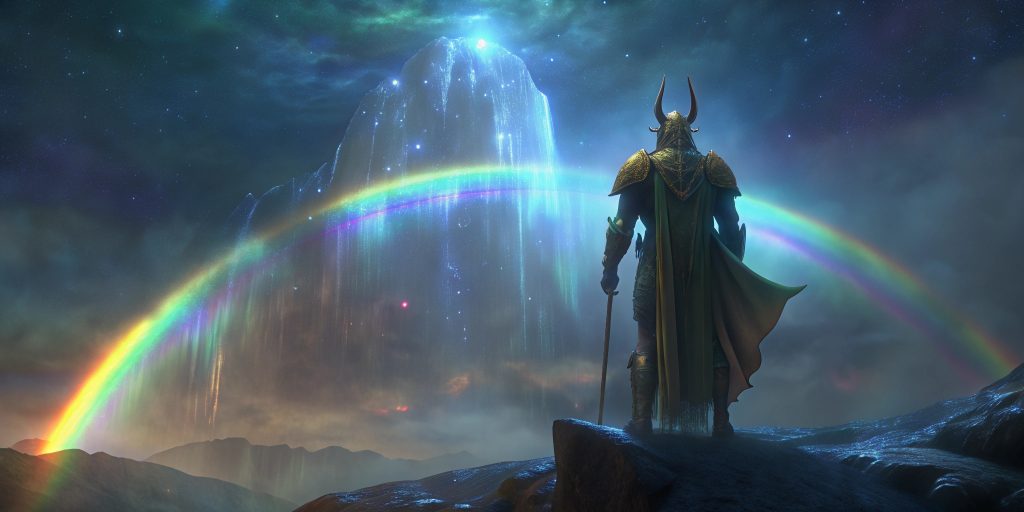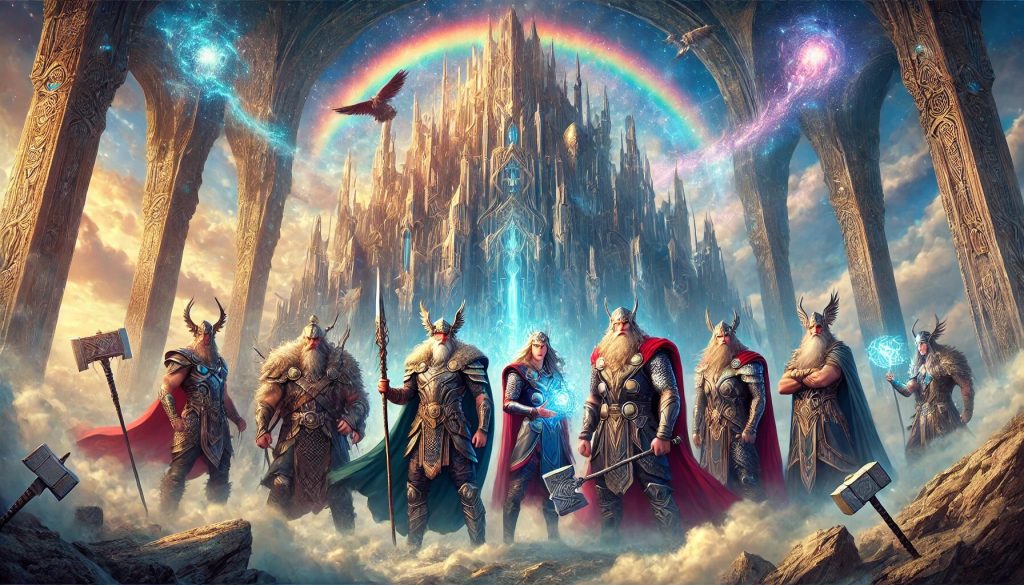Aesir Goddesses, Aesir Gods, Frigg, Heimdall, Loki, Norse Goddesses, Norse Gods, Norse Mythology, Odin, Ragnarok, Thor, Valhalla
The Aesir and Their Role in Norse Mythology: Guardians of Asgard
The Aesir are key gods in Norse mythology, often associated with Valhalla and revered in Icelandic traditions. They watch over Asgard, the gods’ home in the sky. These gods have human-like traits like wisdom, bravery, and even trickery, showcasing the complex nature of the æsir and Vanir.
They are deeply connected to ancient Germanic beliefs. The Poetic Edda and Prose Edda tell us their stories and roles, serving as key texts for understanding the Norse gods and goddesses. These texts show how important they are in Norse mythology, reflecting the values of the Viking Age.
The Aesir and Vanir gods have a special relationship. This relationship shows the power struggles and friendships between gods, adding depth to Norse mythology. So, if you have ever wondered who is Aesir in Norse mythology, keep reading.
The Origins of the Norse Mythology Aesir
The Aesir are key in Norse mythology. They come from ancient Germanic tribes’ beliefs, including tales of Yggdrasil. Their story is woven into early tales of these communities’ spiritual views. Over time, their legend grew through stories, ending in written texts showing their divine importance.
Historical Context of the Aesir
The Aesir’s history tells us about the society and culture back then. They were worshipped across Scandinavia, showing a society that valued gods and life on earth, particularly the Aesir gods of Norse mythology. This belief system helped people understand the world and their place in it.
Records like the Poetic Edda and the Prose Edda show their big role in Norse lives. They highlight the Aesir’s significance in everyday life, especially in the context of the Vanir and Aesir.
Connections with Old Norse Culture
The Aesir were more than gods; they were part of Norse identity. Festivals and rituals celebrated them, showing them to be protectors and keepers of order. Their values reflected society’s norms and struggles.
This shows a culture deeply influenced by mythology, particularly the tales of the æsir and Vanir gods. Divine power touched every part of life.
Key Aesir Gods and Goddesses
The aesir gods Norse mythology include many important deities. Each one has special qualities and roles in the myths, helping to tell the stories of ancient Scandinavian culture.
Odin: The Allfather
Odin is the Allfather of the Aesir gods. He is known for his wisdom and leadership. He seeks knowledge, even if it means making big sacrifices.
His love for war and death shows his strong power. He is a key figure in the gods’ world, representing the ideals of the æsir in Scandinavian mythology.

Thor: The God of Thunder
Thor is the god of thunder and is very loved. He is strong and protects the gods and people from giants. He fights with his hammer, Mjölnir.
Thor stands for courage and strength. He keeps the world safe from harm, a duty shared by many Aesir gods of Norse mythology.
Frigg: The Motherly Protector
Frigg is Odin’s wife and a motherly figure. She is a goddess of family and home, revered among the æsir gods of Norse mythology. She is wise and helps keep peace in Asgard.
She supports her family and ensures harmony. Frigg is a key part of the æsir gods and plays an essential role in their stories.
Loki: The Trickster Among Us
Loki is known for his trickster ways. He is cunning and often causes trouble, much like the trickster figures in Scandinavian mythology. His actions affect both gods and humans.
Despite his mischief, Loki adds depth to the myths. He shows the complex sides of the divine, reflecting the duality of the æsir and Vanir in Norse mythology.
The Aesir and Their Role in the Pantheon
The Aesir are key in the Norse pantheon. They are the main gods in Norse myths. Their power and roles show a clear order in the gods’ world.
Hierarchy of Norse Gods
The gods are organized in a clear order, with Bragi and Sif among the prominent æsir gods of Norse mythology. Odin, the Allfather, leads with wisdom and strength. Thor, the god of thunder, and Frigg, the protector, follow him.
This order shows each god’s special traits. It makes the gods’ family dynamic clear.
Aesir vs. Vanir: Understanding the Differences
The Aesir and Vanir have different values. The Aesir value war and power, while the Vanir focus on fertility and prosperity.
Their battles and peace show the value of working together. This adds depth to Norse myths.
Guardianship of Asgard
In Norse mythology, the Aesir protect Asgard from threats. They fight giants, known as Jötnar, to keep their realm safe, which shows that they defend not just Asgard but the whole universe.
Defending the Realm of the Gods
The Aesir always watch over Asgard. They fight against chaos to keep order, and their battles show how important their role is in keeping the nine worlds balanced.
It’s not just about physical strength. They also protect their spirits. This is a big part of Norse mythology, where the Aesir play a central role in the tales of Valhalla.
The Role of Heimdall as a Guardian

Heimdall is a key guardian of Asgard. He can hear the grass grow and see far away, abilities often attributed to the wise æsir gods. This makes him a great protector, much like Thor in his battles to slay giants.
He guards the Bifröst, a rainbow bridge to Midgard. His watchfulness keeps peace and stability in the universe and symbolizes defending the realm.
Aesir Norse Mythology: Legends and Tales
Aesir Norse mythology is filled with exciting legends and tales. These stories show epic battles and heroic acts, highlighting the bravery and strength of these gods.
Thor battles giants, and Odin uses clever war strategies. These stories show the values of the Norse people, who value honor, courage, and sacrifice.
Epic Battles and Feats
Epic battles are key to understanding the Aesir. They show the gods’ drive for justice, much like Tyr, and their commitment to protecting their realms. Thor fights the Midgard Serpent, showing the Aesir’s determination.
Odin is known for his cleverness and strength in battle. His stories show the Aesir’s bravery and wisdom.
The Narrative of Ragnarök
Ragnarök is at the heart of Aesir Norse mythology. It’s a story of a great battle between the Aesir and their enemies. This event shows destruction and rebirth.
The stories of Ragnarök warn of the end, a cataclysmic event involving the Aesir and the Vanir. But they also show the cycle of life and death. They highlight the importance of the Aesir in Norse culture.

